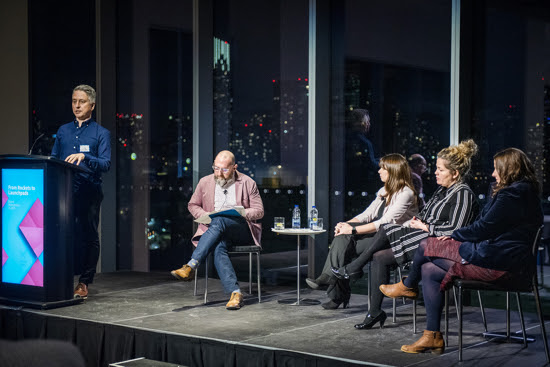On March 6th, we hosted an event at the Globe Centre in Toronto. The theme was born out of a simple observation: when marketing folks talk about brand reinvention, we tend to focus on the highly visible stuff.
Yet these days it’s often a set of internal shifts behind the scenes that make the biggest difference in putting a brand on stronger footing. A killer strategy, a fantastic culture, the right technology, the ideal structure and processes—these levers have just as much power as that shiny new logo to shift your brand into high gear.
We invited a trio of marketing change-makers to discuss this topic on a panel moderated by our own Peter Petralia:
- Stacey Jaffe: Executive Director, Digital Experience for Scholastic
- Mary Cochrane: Director of Marketing Strategy for the LCBO
- Paula Port: Director of Brand Content for Tourism Toronto

Here’s a recap of three key ideas that emerged from the conversation, including some tips you can apply in your own work driving change.
1/ Everything is Connected.
All of the internal factors driving change in marketing departments—strategy, structure, process, culture, tech—are deeply intertwined. Even those that may seem to be miles apart.
“Sometimes strategy and operations can feel like opposites”, admitted Mary Cochrane. But they shouldn’t be. “Great, you’ve got a journey map. But how does it show up in your briefs, your post-mortems and team discussions?”
Stacey Jaffe agreed. “I don’t think you can be good at operations if you’re not good at strategy. And vice versa.”, she said. “Strategy and operations are one and the same. The people who succeed will be those that that can bring these things together. The ideal is to remove the barriers and disconnects between thinking and action.”
Paula Port shared her experience at Tourism Toronto, where moving the change forward meant addressing not only strategy but also culture. “We were looking at the brand. Updating it.”, she explained. “But as this happened we also realized the evolution of our story needed to be matched by shifts in our culture and the way we operate internally. How do we take this new story and then own it and operationalize it?”
2/ Aligning People is Vital.
The glue that connects all of these internal elements—strategy, operations, culture and technology—is, of course, people. If leaders, teams and individuals are well aligned, the marketing function as a whole becomes stronger.
Mary put it this way: “Alignment is so important, whether that’s in how you see your audience or how you see your goals. Everyone needs to understand. This is what we’re doing. This is why.”
Peter agreed: “If I don’t know why I’m doing something, what I’m doing or how I’m doing it don’t really matter.”
Any tips for change-makers who want to create stronger alignment?
Mary pointed to the power of shared KPI’s: “When the outcome you’re working towards is clear, that barrier or gap between right thought and right action is reduced.”
Peter pointed to the importance of understanding organizational culture: “To align people, you need to understand your culture and how new information is propagated and spread.”
For Stacey, the best way is to think deeply about your talent strategy: “In my opinion, modern marketers must be good at the art as well as the science. I expect the people on my team to think in terms of hypotheses. To be able to conduct experiments, test out what works. I want tech-savvy, curious, strategic thinkers with real business sense.”

3/ Technology’s Benefits and Risks
Speaking of technology, the panelists had plenty to say about its potential—and also the associated risks.
Paula argued that all technology decisions must be driven by the overall strategy: “There is definitely a lot of pressure these days. Looking at what everybody else is doing and thinking ‘Why are we not doing that?’ A strong strategy helps you wade through all that clutter and get to the right place.”
Mary expressed concerns about technology distracting marketers from other important things: “I think we’re too focused on looking at how does A convert to B. I think the lost art is really immersing yourself into the customer’s needs and the customer experience. We’ve replaced that mindset with ‘if I do this then this will happen and I want to show this on a dashboard to my exec. team’.”
Stacey is a proud martech enthusiast, but she also shared some words of caution: “My role reports to the office of the CTO. I’m excited by what technology makes possible. But here’s a key question that doesn’t get asked enough: what does your staff need to actually use this technology? I’ve worked in organizations where we had the gold standard tech but we were getting so little value from it because nobody could use any of the darn features!”
This anecdote sums the evening’s overall message quite nicely. Vision is nothing without the ability to execute. Strategy and operations are truly inseparable. Marketing change-makers looking to re-invigorate their brands must invest their time and energy accordingly.


